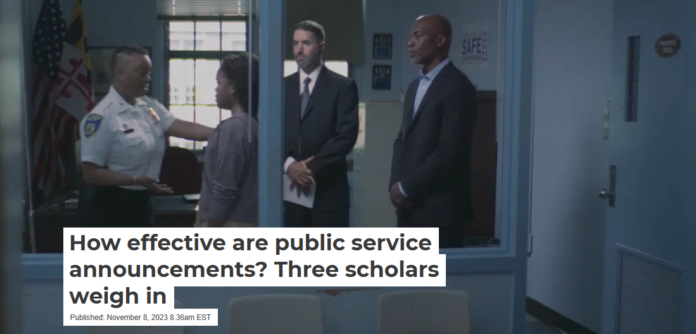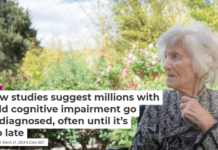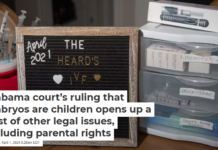

Holli H. Seitz, Mississippi State University; Jessica Myrick, Penn State, and Sara C. Doan, Michigan State University
When Erek L. Barron, U.S. attorney for the District of Maryland, premiered a 60-second video that seeks to show how gun violence devastates families, he said his goal was to create an innovative public service announcement that would help “turn around violent crime and improve safety in our neighborhoods.”
Titled “Goodbye,” the video PSA starts with a high school girl, Tasha, getting a surprise visit from the ghost of her brother, “T,” who tells his sister that he won’t be home and that she is now in charge.
After T disappears, Tasha learns from law enforcement and Barron that her older brother has been shot and killed.
While the PSA – released in September 2023 – is heartbreaking, a critical question remains: Will it work? To answer that question, The Conversation reached out to three communication scholars for their perspectives on the effectiveness of PSAs.
Jessica Gall Myrick, professor of health communication
While PSAs can prompt people to talk about a particular topic and keep it front of mind, using PSAs to persuade people to actually change behavior is more difficult.
Some people simply are not ready to change. They are at what researchers call the “precontemplative stage.” For such people, a PSA can be more persuasive if it just gets them to think about the topic. One strategy to achieve this end is to appeal to people’s emotions.
However, just provoking an emotional response will not necessarily lead to a change in behavior. If audiences are overwhelmed with fear or anger, they often reject the message or discredit its source.
When encouraging audiences to emotionally invest in a topic, too much of any one negative emotion may backfire, while not enough will leave them uninterested, perhaps believing the topic is not very important.
Research suggests that many audiences often respond more favorably to messages that offer some hope, at least by the end. Hope is an important emotion because it can boost our confidence in our ability to handle the threat discussed in the PSA.
In the case of a PSA like “Goodbye,” the sadness or sympathy evoked by showing the grief of the little sister may not immediately change anyone’s policy position or attitude about guns. However, it is memorable – it has the potential to keep people thinking about the issue of gun violence.
“Goodbye” also makes the impact of gun violence more concrete – it feels less abstract than a news story filled with statistics about injuries or deaths.
When stories evoke feelings of empathy and identification with the people directly affected by a social issue, they can help audiences to start to think more, and more often, about the issue’s effects on both themselves and on society more broadly, even if they do not instantly change behavior.
Holli H. Seitz, professor of communication
When they work, media campaigns – which often include PSAs – can have small beneficial effects on people’s behavior and knowledge. However, sometimes PSAs have unintended effects or even harmful effects on behavior. In such cases, the effects are called “boomerang effects” because they go in an unexpected direction.
Case in point: From 1998 to 2004, Congress appropriated over US$1.2 billion for the National Youth Anti-Drug Media Campaign. However, an evaluation found that the media campaign failed to have favorable effects and may have even promoted the perception that drug use among others was normal.
Even in cases where the message of a PSA is effective, there are other factors to consider.
For one, a lot of PSA research was conducted before the rise of social media. The changing media landscape may make it more difficult for PSAs to wrestle people’s attention away from whatever else they’re viewing.
Secondly, PSA creators don’t always do enough to ensure that their PSAs reach their intended audience. Getting a PSA into the media platforms that the target audience uses – and showing it frequently – is key to see effects. The limited effects of past programs, such as the Community Intervention Trial for Smoking Cessation, may be attributable to a lack of sufficient exposure to key messages.
To increase the effectiveness of PSAs, we can look to communication research for guidance. Communication scholar Seth Noar says that campaigns are more likely to be effective when campaign creators conduct research with the intended audience to understand the behavior they hope to change and pretest messages for effectiveness. For example, a campaign to encourage people in Victoria, Australia, to reserve ambulances for emergencies used audience research to inform their campaign development. An evaluation of that campaign showed desirable effects on public attitudes toward the appropriate use of ambulances.
Sara C. Doan, assistant professor of experience architecture
I argue that telling a relatable story makes people want to act. By avoiding the lectures, such as Nancy Reagan’s “Just Say No” anti-drug campaign, and the ironic pictures and quotes from New York City’s posters of crying babies to prevent teen pregnancy, Maryland’s PSA invokes a real situation: how families of gun violence victims deal with losing a family member.
This story allows people to bring their own knowledge, experience and social connections to the problem of gun violence, making people want to act. T tells his younger sister, “You’re in charge right now, Tasha. … Just feed my birds for me, alright?” This dialogue feels genuine, without the cheesiness that made people joke about previous anti-drug PSAs.
People respond better to real images and situations in PSAs, especially when the topic is unpleasant. The “Goodbye” PSA shocked me but doesn’t rely on shock value.
I believe a call to action – whether by a local government, nongovernment organization, or a group of citizen activists – that shows how people’s actions will matter would make the PSA’s message more powerful.
Actions also need to follow a PSA to change people’s behavior.
For example, the National Highway Traffic Safety Administration’s campaign “Click It or Ticket” – combined with traffic enforcement begun in the 1990s and still ongoing – has helped raise rates of seat belt use by 8% between 2009 and 2022.
The horrors of gun violence should not be made into a snappy slogan, which, thankfully, Maryland’s PSA avoids. I argue that giving people a concrete action to take – and empowering communities to act through funding and support for on-the-ground efforts – would make PSAs more effective.
Holli H. Seitz, Associate Professor of Communication, Mississippi State University; Jessica Myrick, Professor of Media Studies, Penn State, and Sara C. Doan, Assistant Professor of Experience Architecture, Michigan State University
This article is republished from The Conversation under a Creative Commons license. Read the original article.



















